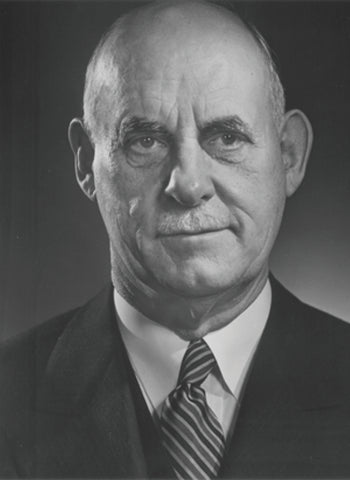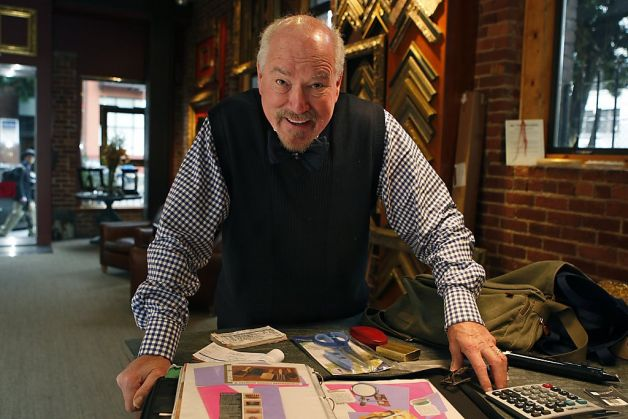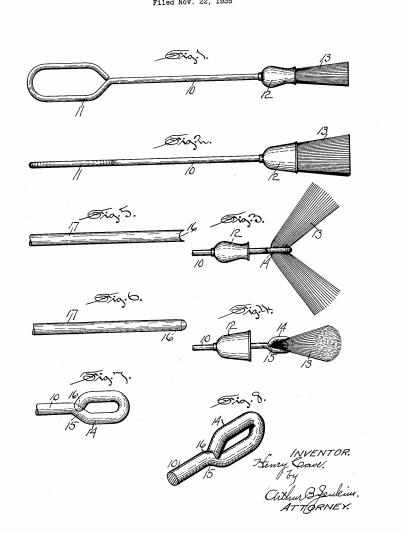The Fuller Brush Story
Alfred Fuller's father would often look at his hands and say "These are your fortune, boy. Be suspicious of anyone who shows you how to make a living without using them.”

Imagine if today was more like the good old days. When products were made to last and landfills weren’t stuffed with plastic remnants of junk. When interactions happened in real life, not on screen. When people just waited for me, their beloved Fuller Brush Man, to stop by with some new products to sell.
Wait, what - you never heard of Fuller Brush? Now this is a story you need to hear.
It all starts with Alfred Fuller, born in Nova Scotia in 1885 - the 11th of 12th children.
Here’s Alfred at 18.
In his own words, ‘a country bumpkin, overgrown and awkward, unsophisticated and virtually unschooled’. And attempting to support himself in Sommerville, Massachusetts, where he had joined some of his siblings.
It didn’t go well at first, to say the least. He was promptly fired from his first three jobs. (Which were trolley car conductor, gardener and horse groom. Quite a variety there, eh?)
Days before his 20th birthday, his brother snagged him a job as a salesman for the Somerville Brush and Mop Company. He got a case of samples and went door-to-door, selling brushes in an uppity-yuppity section of Roxbury, Massachusetts. And this job fit him like a glove.
I washed babies with a back brush, swept stairs, cleaned radiators and milk bottles, dusted floors—anything that would prove the worth of what I had to sell.” - Alfred Fuller (American Heritage article, 1986.)
But Alfred went even further than just being nice and helpful. You know what he did? He paid attention.
When his customers said, “I wish there was a brush for cleaning silk hats”, he marked it down. When they said, “I need a brush that won’t scratch the wood floor,” he marked it down. He noted which brushes sold well and which ones didn’t.
Did You Know? The first brush patent was issued in 1830, marking the start of mass produced brushes. And barely any changes had been made to brush designs for nearly a century! But Alfred Fuller would change that.
To Fuller’s dismay, he also discovered that brushes back then were purposely made to fall apart fast. You know that old saying “the way they made things in the old day”? It wasn’t always true. What’s more, even when they were new, these brushes just didn’t work right! They were as awkward and difficult to manage as a newly-minted teenager.
But Fuller said to himself, “No way, Charlie!” (Well, I don’t think he said those words. But you get the picture.) He had a whole bucket load of ideas for well-made brushes. He wanted his customers to buy things that actually made cleaning easy. And he took these ideas to his employers.
They ignored him. So good ol’ Alfred would keep all that genius to himself.
1906
The Birth of Fuller Brush
DOB: New Year’s Day, 1906

Here’s that original machine!
Total investment: $375
Business Plan:
- Sell from sample kit
- Make requested brushes on nights or weekends
- Deliver orders the following week
- Lifetime guarantee with every purchase
First sale: Brush sold to a woman who used it to clean a radiator
First Week’s Profits: $42.15 (that’s $1205.24 in 2020 dollars!)
Yep, that’s how it all began. Y’know the term “market research”? Fuller was a master of that before it was a “thing.”
"I studied a housewife's needs and we made a brush for every need." That means brushes for cleaning silk hats, spittoons, Victorian furniture, floors and more. Every brush he made was designed for a specific need he’d heard about on his door-to-door rounds.
One fine day, Fuller visited Hartford, Connecticut. Guess what he found there? A brush seller’s paradise. Stately old Victorian homes with intricate panelling, moldings and stair banisters and ornate iron grillwork - that all needed lots and lots of dusting. So Fuller moved his shop to Hartford and named his business the Capitol Brush Company.
Did you know? Some of Alfred Fuller’s ancestors were among the passengers on the Mayflower. Solid American, through and through - just like Fuller Brush products
April 1906
He was such a success in Hartford that he couldn’t keep up with the orders! Because yes, he was still making all of those brushes with his own two hands, on that same machine he’d started with.
But now, it was time to expand. Alfred moved to a larger shop, bought machinery, and made his first hire.
Total revenue in 1906: $8,500
Total product types: 32
1908
Fuller Brush’s first female employee was Alfred’s first wife Evelyn. She outsold him on her very first day. And continued to do so nearly every day for the next two years!
1909
Fuller makes it big!
Alfred wanted the company to spread its wings beyond Hartford. So he placed an “agents wanted” ad in the nationally distributed “Everybody’s Magazine”. Before long, he had 260 new salespeople all over the country.
But you know what the secret to his success was? Not the amount of salesmen.
His secret was in the pledge every salesman had to sign, in which they promised “I will be courteous; I will be kind; I will be sincere; I will be helpful.”
Did You Know? Alfred Fuller taught his men to wear overshoes (aka boots) a size to big. That way, if they got invited into the home, they could quickly and easily step out of the wet, snowy shoes.
1914
Eight years in, and sales were soaring. But now the US was entering a war, and Fuller Brush leaped up to help the war effort. They put their famous quality to good use with specialized military brushes.

1915
Alfred never stayed complacent. That’s why he developed the Handy Brush , a useful little vegetable cleaning brush that was given out FREE to any household visited by a Fuller Brush man.
And his work paid off. Sales increased to $15 million, and the company now had 1000 salesmen.


Did You Know? Alfred had such a good “avoid getting bitten by dogs” strategy that the U.S. Post Office once contacted him for advice on helping mailmen prevent dog bites.
1922
It might surprise you to learn that the term “Fuller Brush Man” was coined not by Fuller Brush, but by “The Saturday Evening Post”! The beloved character soon began to pop up in comic strips, and later in movies.
Here’s an ad from a 1922 copy of The American Legion Weekly seeking more sales men. Wouldn’t YOU want the job, after reading this?

Did You Know? One of Fuller’s favorite aphorisms was “the word ‘American’ terminates in ‘I can,’”
1923
World Record!
Yup, now Fuller Brush really went to the next level with the opening of their new Hartford, Connecticut factory, the largest factory in the world at the time.
Have a peek:

And what a factory it was! Alfred didn’t just craft products there. He had an entire research division. Dozens of inventors were employed in Fuller’s engineering department, always looking for ways to make cleaning easier - better carpet sweepers, better floor brushes, better brooms.
Can I show you this little clip here? You’ll see exactly how Fuller Brush looked back in the day.
And we’re not finished yet. Alfred Fuller didn’t just tinker with products. He also had his engineers invent brush-making machines and other machinery that would create products that met his standards.
If you ever fancy a dig through the U.S. Patent and Trademark Office files, you’ll find more than 300 patents held by the Fuller Brush Company.
Like this one here:
1933
By this time, Fuller Brush had become a part and parcel of American culture. And now, it would even be “Disney”fied! United Artist and Disney’s “Three Little Pigs” has the wolf dress up in a Fuller Brush man disguise to try to lure the pigs to let him in.

1940s
Once again, Fuller Brush had to divert a lot of resources to help the war effort. Y’know how many Fuller brushes made it onto the WWII front? 40 million.
1942
Alfred’s son Howard developed luxury hair brushes that were sold with a five-year guarantee.

1943
Finally, after a long and successful career, Alfred retired and handed over the reigns to his son, Howard Fuller. Following in Dad Fuller’s footsteps, Howard kept on innovating, bringing in more and more products to make life easier at home. Brushes, toiletries, vitamins, household cleaning solutions and more.
1948
Fuller Brush reaches new heights of fame - yup, it makes it onto the big screen with “The Fuller Brush Man”, a comedy starring Red Skelton. Have you watched it yet? It’s a real rip-roarin’, laugh inducing comedy/crime/romance film involving a clumsy, down-on-his-luck Fuller Brush man who accidentally gets caught up in a murder case. And guess what the murder weapon is? Not telling...

1950
Then it happens again! People just can’t get enough of Fuller Brush. “The Fuller Brush Girl” movie is released, starring Lucille Ball, a down-on-her-luck Fuller Brush girl who accidentally gets caught up in a murder case.

The reason Fuller is getting all this media love? Because by now, housewives have been using their brooms and brushes literally for decades without having to replace it! And what could be more love-worthy than that?
That reminds me. You know how plastic-filled oceans and landfills are destroying our environment? Fuller Brush’s products are an antidote to this problem.
Let’s say you buy a broom that lasts for 40 years - as many Fuller Brush customers have done. How many cheap plastic brooms have you just rescued from the landfills? I’d venture nearly 80.
1956
The Fuller Brush line expands to include 340 products including aerosols, detergents and more. The product brochure becomes a catalog with an annual print run of 5 million copies.


1972
Fuller Brush manufacturing operations are moved to Great Bend, Kansas by the new owners, Sara Lee Corporation. And this very factory is where our products are still produced today! You heard that right - still produced in that same factory, using the same patented designs.
1985
Even as door-to-door salesmen became less and less common, for Fuller Brush, ALL sales were still generated door-to-door until 1985.
It was only in the next few years that Fuller Brush introduced mail-order catalogs - they sent out 10 million a year! Several outlet stores were also opened throughout the country.
1987
Eager to attract the “cream of the crop” sales reps, Fuller Brush raised commissions to up to 50% of the sale. Yup, that’s right. Fuller doesn’t cut corners and does whatever it takes to maintain their high standards.
According to Derek Stryker, then vice-president of Fuller’s household division, there were salespeople earning more than $50,000 a year at that point. In modern dollars, that’s $110,522. After all these years, Fuller Brush was still giving thousands of Americans a way to earn a good, honest living - with minimal overhead.

(NYT article, May 1989 - Click to read)
1996
In 1931, Frank Stanley Beveridge - Director of Sales at Fuller Brush - left to found his own company, Stanley Home Products. But in 1996, the company returned to its roots when Fuller Brush acquired Stanley Home Products.
Now Fuller Brush’s product line was more extensive than ever.
1997
Fuller enters the 21st century ahead of time with the launch of their brand new website! (Though it might seem plain and cumbersome to you, this was actually a nice, clean design for the 90s!)
The website took off fast, getting 1800 page views per month for the first 10 months. And this was before internet shopping was the norm, showing just how popular Fuller Brush was.

2013
San Francisco’s last active door-to-door Fuller Brush man, Norman Hall, was interviewed on Radio Sausalito. His first sale? A green and white Kitchen Brush in 1971. 40+ years later, at 75, he was still walking 5-10 miles a day delivering goods!

Saint Helena native David Sabin bought Fuller Brush, determined to introduce 21st century America to the nostalgic brand. So he created the 1906 Heritage Line inspired by Fuller Brush’s original products. These iconic items were made with every detail perfected, exactly as Alfred Fuller had done.

At the same time, Fuller Brush also embraced the digital age with a modernized, easy to navigate website.
2018
When Sam Max, our new CEO, received the opportunity to purchase the Fuller Brush Brand, he grabbed it. He wants to bring Fuller Brush back to its old iconic glory. And part of that strategy includes reviving the dealer program! Yes - anyone can become a Fuller Brush dealer and bring these products to their community.
As he says “We’re returning to Alfred Fuller’s original philosophy, started in 1906: ‘Make it work and make it last.' Already, we’ve returned manufacturing to the former Great Bend, Kansas location, using the same designs that made Fuller Brush famous. And we’ve brought more than 60 beloved products back to life - bringing our total available products to 175!”
2019
Today, the Fuller Brush man meets you where you are - that is, online and through your favorite social media channels! Hear what our fans are saying, learn about new products, and participate in exciting contests.
And of course, you can always find us here on our beautiful, updated, interactive website.
But there's nothing like seeing a real Fuller Brush Man in action. That’s why we launched a YouTube channel, where a modern-day Fuller Brush Man demonstrates the products for you.
And if you hate shopping on the screen? Reach out to one of our over 300 dealers that still sell Fuller Brush products. Or, just get one of our beautiful printed catalogs and give your fingertips the joy of fingering thick paper.
Here’s to old fashioned quality. To modern sustainability. To the same cleaning products that kept Mom’s house sparkling for decades.









